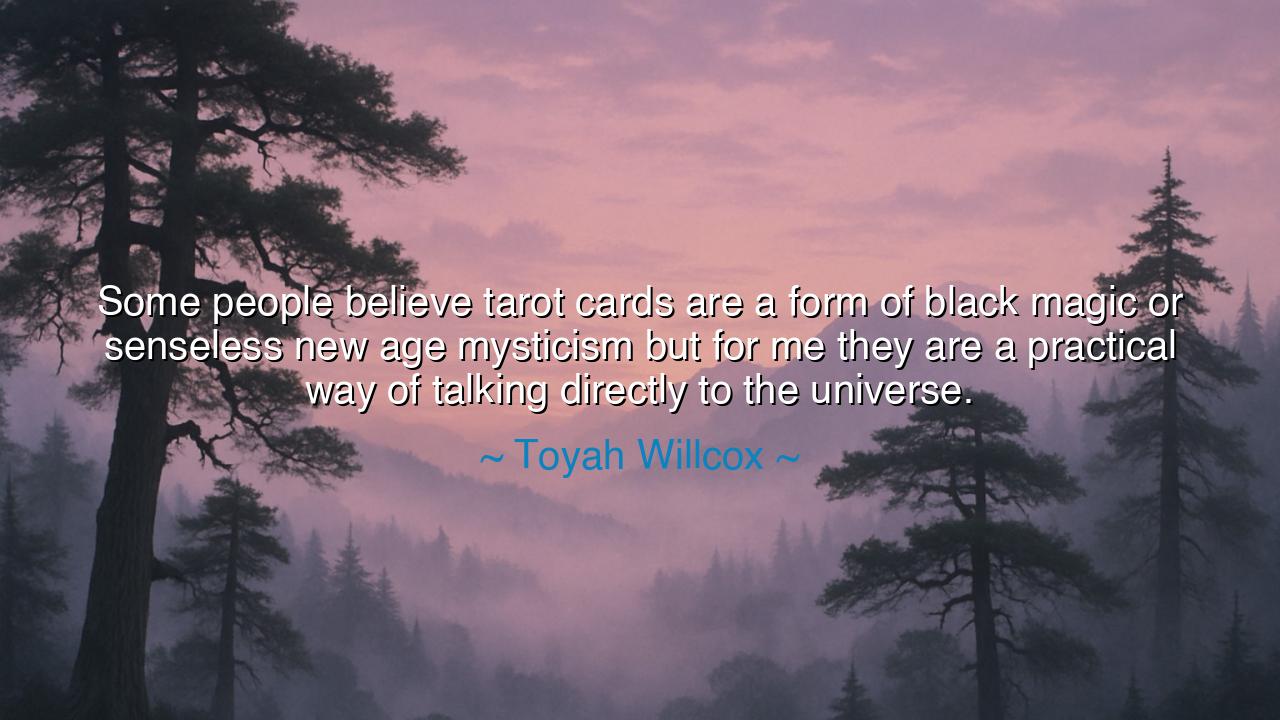
Some people believe tarot cards are a form of black magic or
Some people believe tarot cards are a form of black magic or senseless new age mysticism but for me they are a practical way of talking directly to the universe.






In the vast, ever-turning wheel of human experience, there are those who look to the heavens and seek answers—answers not from the rational mind, but from the deeper, more mysterious forces that govern our lives. Toyah Willcox, in her reflection, speaks to this deeper connection when she states, "Some people believe tarot cards are a form of black magic or senseless new age mysticism, but for me they are a practical way of talking directly to the universe." These words are not just an endorsement of the tarot but a recognition of humanity’s eternal search for meaning, for a language to bridge the seen and unseen, the known and the unknown. In Willcox's words, we see an echo of the ancient wisdom that humans have always sought to connect with the divine, the cosmic, or the invisible forces that guide our destinies.
The ancients, who were deeply attuned to the mysteries of the universe, understood that there were channels through which the divine could be accessed. In ancient Greece, the oracle at Delphi was revered as a conduit to the gods, where Pythia, the high priestess, would deliver cryptic messages believed to be from Apollo. People came from far and wide, seeking answers to life’s most pressing questions, believing that the gods spoke through this earthly intermediary. The oracle’s words, though often veiled in symbolism, provided guidance that shaped the decisions of kings, generals, and common folk alike. The tarot, as Willcox suggests, serves a similar purpose—it is a tool that allows us to communicate with the universe, to seek wisdom and guidance from forces that transcend our individual understanding.
Consider the story of Julius Caesar, whose encounter with the soothsayers and augurs was a common practice in the ancient world. The Romans, particularly in times of war or political decision-making, sought the counsel of those who could read the signs—the flight of birds, the patterns of entrails, or even the reading of omens. Caesar himself, before crossing the Rubicon, sought out such signs to ensure that his actions were in alignment with the will of the gods. His belief in the guidance of these mystical practices did not make him weak, but gave him a deeper sense of connection to the divine order of the world. For Caesar, just as for Willcox, these practices were not about mysticism or magic, but about seeking practical guidance from the forces that shaped human destiny.
The tarot, much like the ancient oracles, speaks to the desire for meaning beyond the physical world. To the skeptic, the tarot may seem like mere fortune-telling, a superficial game of cards with no deeper significance. But for those who approach it with an open mind, as Willcox does, it becomes a tool for reflection, introspection, and a way to align oneself with the greater forces that govern our lives. The cards become symbols—representations of archetypes, emotions, and universal themes that can shed light on our inner selves, our relationships, and our destiny. They act as a mirror to the soul, revealing not just future outcomes but the lessons we must learn to navigate life with greater wisdom and clarity.
Willcox’s words also remind us of the deeper psychological truths that underlie all mystical practices. The tarot is not just about the cards themselves, but about the way they allow us to tap into the unconscious mind, the place where our deepest desires, fears, and intuitions reside. Carl Jung, the famous psychologist, understood this well. He believed that symbols, like those found in the tarot, were a way for the unconscious mind to communicate with the conscious, offering insights and wisdom that we may not have access to in our waking, rational state. To Jung, the tarot was a tool for self-discovery, a way to confront the shadow self and integrate the parts of our psyche that we often keep hidden. In this light, Willcox’s view of the tarot as a practical tool for connecting with the universe becomes a way to connect with our own deeper truths, guiding us to a fuller understanding of who we are and why we are here.
The lesson here is profound: in a world that often values the rational, the logical, and the scientific, we must not forget that there are other ways of knowing, of seeking truth. The tarot, much like the oracles of ancient times, is a tool—a sacred language through which we can communicate with the universe and our own deeper selves. It is not about superstition or blind belief, but about opening ourselves to the mysteries of existence and seeking guidance from the unseen forces that shape our lives. It is a reminder that we are not alone in the vastness of the universe, but are part of a greater tapestry, one in which we can find meaning if we are willing to listen.
Practical action calls us to embrace the mystical alongside the rational in our quest for understanding. Whether through the tarot, meditation, or simply spending time in reflection, let us allow ourselves to explore the deeper layers of our consciousness and connect with the larger forces that shape our lives. Seek balance between the seen and the unseen, the known and the unknown, for it is in this dance that we find not only wisdom but also a deeper sense of purpose and clarity. Just as the ancients consulted oracles and soothsayers, we too can find answers to the questions that trouble our souls—not in the faint whispers of chance, but in the wisdom that comes from a connection to the divine, to the universe itself.






AAdministratorAdministrator
Welcome, honored guests. Please leave a comment, we will respond soon